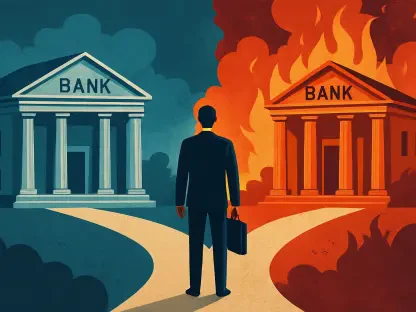The Reconstruction Finance Corporation (RFC) played a transformative and innovative role in shaping U.S. economic policy, making a significant mark on both governmental intervention and the broader market landscape. Established in January 1932 at the behest of President Herbert Hoover, during the throes of the Great Depression, the RFC was designed to inject emergency credit into struggling businesses, introducing an unprecedented level of government involvement in the private sector. Despite Hoover’s electoral defeat to Franklin D. Roosevelt later that year, the RFC not only survived this transition but also thrived, becoming a pivotal instrument in stabilizing the U.S. economy and laying the groundwork for future government-market interactions.
Early Interventions and Banking Sector Stabilization
Initial Phase of RFC’s Operations
In its nascent stage, the RFC was intensely focused on stabilizing the teetering banking sector, which was in dire need of support to regain public confidence and ensure economic stability. By directly investing in banks, it emerged as a key player in this arena, significantly enhancing liquidity and assurance within the financial system. By September 1934, the RFC had effectively become a partial owner of approximately half of the banks in the United States, a testament to its far-reaching influence during this period. This intervention was not merely a rescue operation but also a strategic move to restore the banks’ lending capabilities, thus reviving economic activities central to preventing further financial collapse.
Moreover, the RFC’s approach did more than stabilize the banking sector; it set a precedent for future government interventions. By participating actively in the banking system, the RFC demonstrated the potential for government-backed entities to play crucial roles during economic distress. Its initial operations underscored the importance of liquidity and confidence in supporting the banking infrastructure, ensuring that credit remained accessible to businesses and consumers alike. This intervention not only alleviated the immediate crisis but also laid the foundation for sustained economic recovery, influencing future policy frameworks aimed at safeguarding financial stability.
Broader Economic Stabilization
As the RFC evolved, its mission expanded beyond banking to become a broader stabilizer in the U.S. economy. Acknowledging the interconnectivity of various economic sectors, the RFC began to channel resources into innovative industries, particularly focusing on housing to stimulate employment and address societal needs. Its most notable contribution during this phase was the creation of the Federal National Mortgage Association (Fannie Mae) and the introduction of the 30-year mortgage. These initiatives not only stabilized and expanded the housing market but also established a legacy that still influences government-backed mortgage trading today.
The focus on housing was not merely an economic decision but a strategic societal one, as it spurred job creation across multiple sectors, including construction, manufacturing, and real estate. The RFC’s involvement facilitated long-term homeowner access to credit, transforming the housing market into a resilient economic pillar. Importantly, these strategic interventions illustrated how targeted investment in critical sectors could yield robust economic growth, a lesson that has guided subsequent government initiatives aiming to foster innovation and sustainable development across different industries.
Impact of World War II and Post-War Legacy
Economic Boost During Wartime
The outbreak of World War II marked another pivotal phase for the RFC, wherein it assumed a crucial role in enhancing the U.S. industrial capabilities required for wartime production. The RFC’s involvement was instrumental in financing the manufacture of essential war machinery and infrastructure, such as airplanes, and in supporting pilot training programs. By doing so, the RFC significantly contributed to bolstering the nation’s defense readiness, while simultaneously fueling economic growth through increased industrial activity. This strategic alignment between economic policy and national defense not only ensured a robust wartime economy but also showcased how government intervention could effectively coordinate resources in times of national crisis.
This wartime strategy also highlighted the importance of collaboration between the public and private sectors, as the RFC worked closely with industries to meet the country’s defense needs. The ability to adapt swiftly and respond to emergent challenges demonstrated the flexibility and effectiveness of the RFC’s organizational model. Beyond its immediate impact, this phase solidified its reputation as a vital tool for navigating complex economic landscapes, influencing how subsequent government entities were structured to achieve coordination and efficiency in addressing national priorities.
Legacy and Influence on Future Programs
The Reconstruction Finance Corporation (RFC) played a crucial and transformative role in U.S. economic policy, leaving a lasting impact on both government intervention and market dynamics. Established in January 1932 by President Herbert Hoover amidst the Great Depression’s crippling effects, the RFC’s primary goal was to provide emergency credit to struggling businesses, marking an innovative government intrusion into the private sector. Even after Hoover lost the presidential election to Franklin D. Roosevelt later that year, the RFC not only persisted through the political shift but flourished, acting as a stabilizing force in the U.S. economy. Its actions were not just temporary fixes; the RFC laid the foundation for future interactions between the government and markets, depicting a new era of economic strategy. As an essential mechanism in navigating fiscal turmoil, the RFC demonstrated the government’s ability to play an ever-more influential role in economic stabilization and development, shaping policies that would endure through time.









